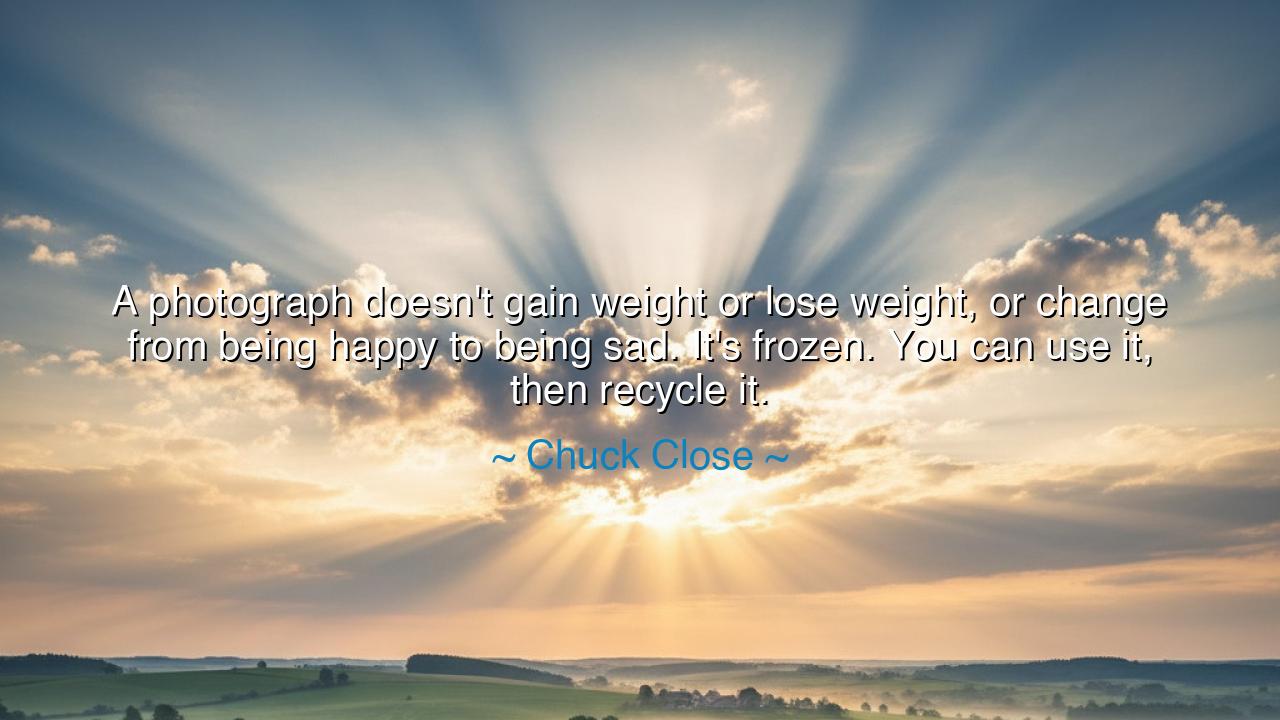
A photograph doesn't gain weight or lose weight, or change from
A photograph doesn't gain weight or lose weight, or change from being happy to being sad. It's frozen. You can use it, then recycle it.






The words of Chuck Close, “A photograph doesn't gain weight or lose weight, or change from being happy to being sad. It's frozen. You can use it, then recycle it,” speak to the ancient tension between time and permanence, between the fleeting nature of human life and the unchanging quality of art. In his observation, there is both awe and resignation. The living body alters—grows old, weakens, shifts with sorrow and joy—but the photograph remains, unchanged, eternal, frozen in its moment.
The origin of this reflection lies in Close’s life as a painter and photographer, renowned for his massive, detailed portraits. His work was born from the intimacy of the face, from the way expressions and identities can be both fleeting and monumental. Yet he knew, as all artists do, that a portrait—whether painted or captured through a lens—does not breathe. It does not feel sorrow, nor does it rejoice. It becomes a relic, a fixed artifact of a moment that no longer exists. Unlike flesh, the photograph does not know transformation.
This truth recalls the wisdom of the ancients. The Egyptians carved the images of their pharaohs into stone, believing that such likenesses might carry their presence into eternity. The Greeks and Romans cast statues to preserve the nobility of their heroes, even as their bodies fell to dust. And yet, just as Close observed, these images are frozen, unable to tell the full story of a life in flux. The marble face of Caesar does not show the weary heart of a man betrayed. The photograph of a laughing child does not reveal the grief they may later endure.
Close’s words also carry a warning: art is a snapshot, not the whole truth. A photograph can be used, admired, shared, even recycled—but it is not alive. It cannot reveal the complexity of a soul across years of change. To confuse the image with the living being is to fall into illusion. In our age, when photographs are everywhere, his words remind us not to mistake permanence of image for permanence of self. Life is change, but the image is stillness.
And yet, there is power in this stillness. For in a world of flux, the frozen image offers memory. It anchors us, reminding us of who we were, even as we become someone new. It is not truth in totality, but it is truth of a moment, preserved against the erosion of time. Like the footprints left in wet clay, the photograph becomes an imprint of what once was. We may look upon it with joy or sorrow, but in either case, it is a gift: a fixed window into the past.
The lesson for us is clear: treasure photographs for what they are, but do not confuse them with life itself. They are not the soul, but they are echoes. They cannot change, but they can remind. Let them inspire gratitude for the moments we have lived, but do not let them trap us in nostalgia. The living must continue to move, to grow, to feel, even as the images remain forever still.
Practically, this means we must embrace the art of balance. Take photographs, honor them, and let them preserve your memories. But also step beyond the frame. Do not live only in the frozen images of the past—live in the flowing stream of the present. Create new memories that no camera could fully capture. Recognize that while art preserves, only life transforms.
Thus, Chuck Close’s words become more than commentary on photography—they become a meditation on existence itself. We are the changing, breathing beings; the photograph is the shadow we leave behind. Let us honor both—the fleeting pulse of life and the frozen echoes of memory—knowing that together, they tell the story of what it means to be human.






AAdministratorAdministrator
Welcome, honored guests. Please leave a comment, we will respond soon